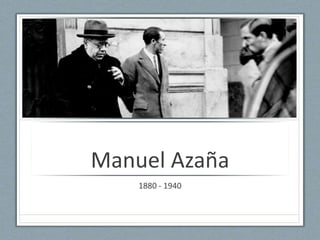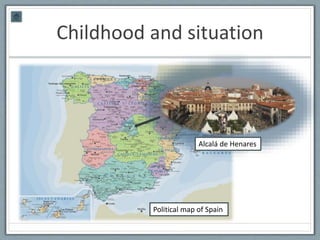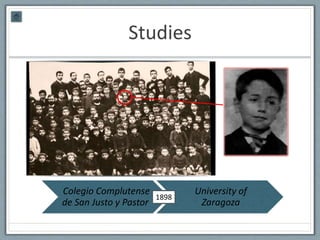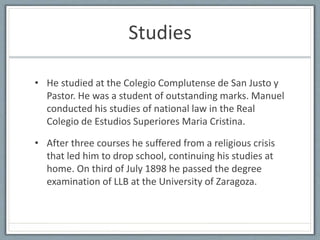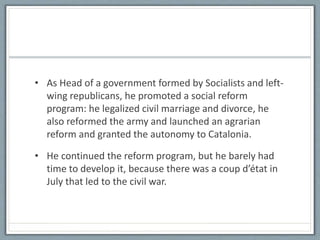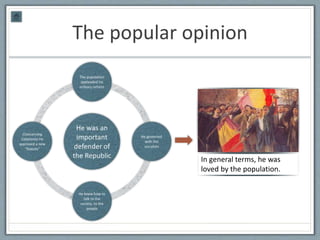Manuel azaña
- 1. Manuel Azaña 1880 - 1940
- 2. INDEX 1. BIOGRAPHY 2. HISTORICAL CONTEXT 3. AZAÑA’S INFLUENCE
- 3. Biography His life, his studies, and what he did to become an important politician of the 20th century.
- 4. 1. BIOGRAPHY 1. Childhood 2. Studies 3. The beginning in politics 4. The Republic 5. Presidency 6. His death
- 5. CHILDHOOD Manuel Azaña Díaz was born in Alcalá de Henares on January 10th 1880. He was a Spanish writer and politician. Manuel Azaña was born in a family of strong economic position and presence in the political and intellectual life of Alcalá. His parents were ESteban and María JosefinaCatarineu Azaña Díaz - Gallo Muguruza. Manuel was the second of four brothers (Gregorio, Josefa and Carlos, were the others). On July 24, 1889 his mother died and a few months later, on January 10, 1890, his father too. Manuel and his brothers went sent to live with their paternal grandmother, Doña Concepcion.
- 6. Childhood and situation Alcalá de Henares Political map of Spain
- 7. Studies Colegio Complutense de San Justo y Pastor University of Zaragoza 1898
- 8. Studies • He studied at the Colegio Complutense de San Justo y Pastor. He was a student of outstanding marks. Manuel conducted his studies of national law in the Real Colegio de Estudios Superiores Maria Cristina. • After three courses he suffered from a religious crisis that led him to drop school, continuing his studies at home. On third of July 1898 he passed the degree examination of LLB at the University of Zaragoza.
- 9. Political beginnings • He joined the Reform Party of Melquiades Álvarez and founded the League for Political Education with Ortega y Gasset. José Ortega y Gasset • He founded the Spanish Democratic Union.
- 10. Beginnings • In 1913 he joined the Reform Party of Melquiades Álvarez and participated with Ortega and Gasset in the founding of the League for Political Education. In 1918 he founded the Spanish Democratic Union, but failed in repeated attempts to be elected to the Parliament of the Restoration (1918 and 1923). He temporarily withdrew from politics to devote himself to journalism, first as a correspondent in Paris (1919-1920), then at Pen (1920-1923) and finally as director revista España.
- 11. The Republic 3. Azaña was integrated into the provisional government as Minister of War. 2. He declared himself supporter of the Republic 1. He left the Reform Party.
- 12. • Under the dictatorship of Miguel Primo de Rivera he left the Reform Party and declared himself a supporter of the Republic, founding Republican Action (1925) while his intellectual prestige kept growing. In 1930 he became president of the Ateneo • With The proclamation of the Spanish Republic (April 14, 1931), Azaña was integrated into the provisional government as Minister of War. He actively participated in the Constituent Assembly and assumed the Presidency of the Council of Ministers when discrepancies between the Church and state relations led Aniceto Alcalá Zamora to leave the cabinet.
- 13. Presidency He won elections in February 1931 for the first time and in 1935 for the 2nd time
- 14. • As Head of a government formed by Socialists and left-wing republicans, he promoted a social reform program: he legalized civil marriage and divorce, he also reformed the army and launched an agrarian reform and granted the autonomy to Catalonia. • He continued the reform program, but he barely had time to develop it, because there was a coup d’état in July that led to the civil war.
- 15. His death • With the war lost, he went into exile in France and resigned (1939). • He died on November 3, 1940.
- 16. • Azaña was gradually isolated, unable to maintain unity and order in the Republican side, with the radicalism and internal conflicts of labor organizations. Lost the war he went into exile to France and resigned the Presidency (1939). • In 1940 he suffered a serious stroke that affected his speech and caused him facial paralysis. A month later, however he seemed to be pretty recovered. With all, in late October he suffered a relapse of which we could not recover. • On November 3, 1940 he died. The funeral took place on the 5 and his remains were deposited in the cemetery of Montauban.
- 17. Historical Context What we know about when he lived (the different historical events that happened before and during his life).
- 18. 2. HISTORICAL CONTEXT 1. When did Azaña live? 2. Before the Second Republic… 3. The Second Republic 4. The Civil War
- 19. When did Azaña live?
- 20. Before the Second Republic… Primo Rivera Dictatorship
- 21. The Second Republic Proclamation of the Republic
- 22. The Second Republic • The causes that helped to the establishment of the Republic were the exhaustion of the political system of the Restoration and the inability of the monarchy to assume their mistakes during the dictatorship. In April 1931 it became clear that the popular discontent was directed to the instauration of the Republic. • So, the Second Spanish Republic started in April 1931. • Alfonso XIII was lonelier than ever, the working class considered him as the symbol of oppression, the middle class couldn’t forgive him the seven years of dictatorship, and even the followers of the monarchy didn’t want to continue with this system. • The proclamation of the Republic was host with euphoria by the majority of the population. For everybody, the Republic represented the hope of a new fairer and more modern Spain. While the country was celebrating the proclamation of the Republic, Alfonso XIII was leaving the palace to the exile.
- 23. The Civil War The division of Spain (September 1936)
- 24. The Civil War • The Spanish Civil War was a national war event that started when General Francisco Franco, rose up against the Republican government, presided by Manuel Azaña. The other countries used that conflict to make of our country a war field for the Second World War. • Internally, the social tensions deriving from the bad economy of the country and the unequal distribution of the money, created a climate of dissatisfaction from the people to their governors • So, the social discontent created an explosive situation that ended with the explosion of a terrible civil war that divided and destroyed Spain.
- 25. Azaña’s influence How his social and political actions influenced the Spanish society in the past and today.
- 26. 3. AZAÑA’S INFLUENCE 1. What did he do? 2. How he became President • His military reforms • His religious reforms 3. The popular opinion 4. The mark he left in our history
- 27. What did he do? From 1931 to 1933 he was the President of the II Republic. From 1935 to the end of the war, as leader of the Popular Front, he became the President of the Republic for the second time . He also created Republican political parties and coalitions.
- 28. How he became a President His military reforms OBJECTIVE 1: TO REDUCE THE NUMBER OF MILITARY OFFICERS OBJECTIVE 2: TO DEMOCRATIZE THE ARMED FORCES How? With the restructuration of the armed forces. With a system of forced retirements How? By retiring the officers that were more implicated with the Dictatorship and the Monarchy.
- 29. How he became a President. His religious reforms After his discourse, the religious orders couldn’t teach any more. The provisional president of the Republic felt dismayed, and resigned. Manuel Azaña was convinced to accept the presidency. Thanks to a brilliant discourse against the expulsion of the religious orders of the country, he won the favour of the Parliament.
- 30. The popular opinion In general terms, he was loved by the population.
- 31. The mark he left in history He established the basis of democracy in Spain He gave the population the tools they needed to have a voice in Spain He became an example in politics because of his clean and wise form of governing Although the Civil War destroyed the Republic that Manuel Azaña had built, and almost nothing from his government has survived until today…
